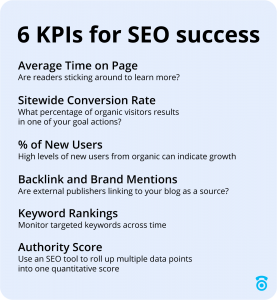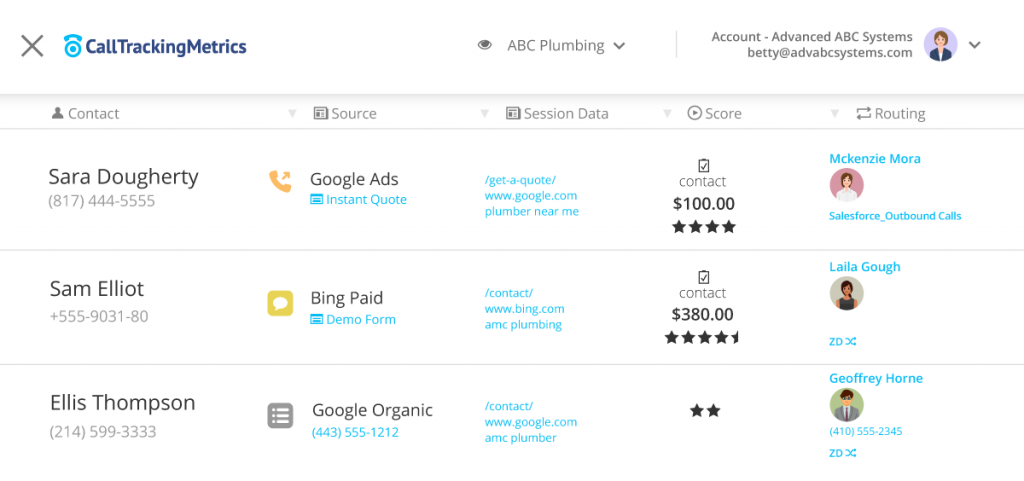How to Measure SEO Success
There are very few quick wins in search engine optimization (SEO). Maybe you fix an errant NOINDEX and see traffic soar tomorrow. But, for the most part, SEO performance is felt over months, not days. A long time frame is one part that makes measuring SEO success hard. Another is that there’s no direct relationship between a dollar spent and a dollar earned, like with paid media. Despite the challenges, there are many ways to track SEO performance. Some obvious. Some less so. All are great at showcasing the hard work you’ve put into your SEO strategy.
Measuring SEO Key Performance Indicators (KPI) with Google Analytics
There are lots of moving parts of SEO. Things like on-page content, site structure, and schema markups. At the heart of all that effort, and basic SEO framework, is the desire to be visible to your audience on search engines–and get them to your site. The easiest way to measure SEO success then, is to use Google Analytics to report on how effectively you’ve attracted your audience to your site.
How many organic visitors did my site have? That’s the main question. In both Universal Analytics and GA4, this answer comes from the acquisition reports. You want to look at the default channel grouping “Organic Search” for an overview of how much traffic search engines have sent to your site. Or, you can look at source/medium if you’re tailoring your strategy to Google vs. Bing or Duck Duck Go. A couple of quick, incredibly high-level questions to ask when looking at the total SEO-driven users or sessions include:
- Did the total increase or decrease since last I looked?
- Did the total increase or decrease versus last year?
Then the fun begins digging into the ‘why?’ behind those topline numbers. Take a look at landing page reports to see which pages are attracting the most organic visitors. Check out event and conversion reporting to see if your organic traffic is valuable. If they’re not converting, maybe you’re targeting irrelevant keywords or your content isn’t speaking to the correct stage of the buyer’s journey.
A few more KPIs for measuring SEO performance might look like this, all through the lens of an organic search segment:
- Average time on page or scroll depth for blog posts – blog posts are meant to get read, is your organic audience sticking around to learn more?
- Sitewide conversion rate – whether your site is selling a product or has a different goal, you’ve got on-site actions that matter to your business. What percentage of your organic visitors results in one of those actions?
- % of new users – while any user is great, seeing high levels of new users from organic can indicate growth. While high levels of returning users might be coming from branded terms not necessarily indicative of SEO success.
Tracking Keyword Rankings to Measure SEO Success
Google Analytics is a good way to measure if SEO is working as a holistic strategy. To drill down further into what is actually making an impact, you’ll want to track specific keywords. A lot of time and effort goes into an SEO’s keyword strategy, so it’s important to monitor the impact of changes.
There are a couple ways to approach tracking keyword rankings and search engine results page (SERP) impressions. And because no data set is 100% complete or accurate, the more the merrier for your reporting.
The first place to monitor your SEO performance is Google’s Search Console. If you haven’t already connected Search Console to your site, it’s free, and there’s never been a better time to start than right now. Once connected, you’ll start to see data related to search results that you can track and compare across time. See which keywords are driving clicks, which are getting impressions, and where there’s room for improvement.
For a little more advanced tracking and context beyond your own site, paid services allow you to set up projects and track keyword ranking across time. Compare keyword performance across time, but also against the performance of competitors. Competitor insight is important, because while you might be improving some targeted keywords, your competitors might be improving even more. Popular paid SEO tools like SEMrush, Spyfu, and Moz give you flexibility to track SEO success across various metrics:
- Backlink and brand mentions – getting links from external websites can be a big win for SEO. Track the overall number of links to your site, and to individual pages.
- Keyword rankings – as mentioned above, you’ll want to monitor targeted keywords across time to view overall average rankings, but also estimated search volume for each keyword.
- Authority scores – whichever tool you choose, there’s like an authority score which rolls up multiple data points, like backlink quality and volume, into one quantitative score of SEO success.

Offline Conversion Tracking
This is where things get fun. Most SEOs are doing some level of online analytics through Google Analytics or another tool. But, not everything happens online. How do you measure the true effectiveness of SEO without accounting for every organic conversion?
Call tracking software uses dynamic number insertion (DNI) to give insights into additional actions traditional marketing analytics misses. With call tracking in place, you can easily monitor and report on the volume of phone calls or SMS messages and live chats driven by your SEO efforts. Like any good marketing metric, you’ll want to segment these activities to get the best insights into your SEO performance:
- Number of sales calls per month – not every call is from a prospect in the buyer’s journey. You can track everything, but make sure you’re analyzing lead gen calls, and not customer service calls.
- % of sales calls to customer service calls – similarly, keeping an eye on this ratio can give a good high level view of the organic audience you’re reaching.
- Volume of spam calls and wrong numbers – SEO is about being relevant. If your keywords are bringing in too much noise, it’s time to re-adjust. Evaluate your keywords ad/or the on-page content to make your messaging is clear.
Lead and Call Scoring
With good offline conversion tracking, you can also add quality scores to your success metrics. In Google Analytics, a lead is a lead. When you start tracking conversions with a tool like CallTrackingMetrics, you have access to data further down the funnel.
Every call, form fill, text, or chat can be scored. Set up automatic parameters to score these activities, or have your sales team score and tag calls manually while they’re having the conversation. What’s the average score for activities attributed to organic traffic, and how does that stack up against other sources like paid or referral? How many sales are attributed to organic, and what’s the close rate? Which products are getting the most traction? All of these answers can help you paint the picture of your SEO performance and even start proving SEO’s return of investment (ROI) as you tie conversions back to organic searches.
Local SEO
For those with businesses with physical locations, you’ll want to measure the success of your local SEO efforts too. You can rely on the built-in analytics of Google My Business (GMB) listings, but you can enhance your insights through call tracking. View call volume for each location and attribute them directly to your Google My Business listing, whether they call from your listing or visit your website first. Monitor your local SEO performance with these metrics:
- Volume of GMB (or other listing) calls
- Ratio of new callers to returning callers from GMB
- Average of GMB vs. overall organic call scores
Reporting on SEO Performance and Results
You’re using Google Analytics, SEMrush, and CallTrackingMetrics. Each has their own metrics and distinctive points of view on the data. Site traffic is up, rankings are down, and average call scores have increased. So how is your SEO successful? You need to pull it all together and analyze the whole picture.
One way to get that done is to use integrations and APIs to add all the context into one of your tools. CallTrackingMetrics can send calls and conversion activity back to Google Analytics to be analyzed there. Or CTM automatically pulls in GA data into its platform for its own reporting.
Or, everything can be pulled together in a nice real-time dashboard using a tool like Google Data Studio. Look at call data, site data, and available keyword data all in the same place. You can create a high level look for internal leadership teams, and more drilled down views to get in the weeds to find your next SEO project.
However you decide to measure your SEO success, be consistent, and continue to monitor long-term. As the SEO landscape, algorithms, and trends change, stay on top of your own performance and adjust.


